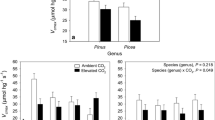Abstract
In the current study, we quantified changes in the growth and alkaloid content of wild poppy, (Papaver setigerum) as a function of recent and projected changes in global atmospheric carbon dioxide concentration, [CO2]. The experimental [CO2] values (300, 400, 500 and 600μmol mol−1) correspond roughly to the concentrations that existed during the middle of the twentieth century, the current concentration, and near and long-term projections for the current century (2050 and 2090), respectively. Additional carbon dioxide resulted in significant increases in leaf area and above ground biomass for P. setigerum at all [CO2] relative to the 300μmol mol−1 baseline. Reproductively, increasing [CO2] from 300 to 600μmol mol−1 increased the number of capsules, capsule weight and latex production by 3.6, 3.0 and 3.7×, respectively, on a per plant basis. Quantification of secondary compounds (i.e. those not involved in primary metabolism) included the alkaloids morphine, codeine, papaverine and noscapine. The amount of all alkaloids increased significantly on a per plant basis, with the greatest relative increase occurring with recent increases in atmospheric carbon dioxide (e.g. from 300 to 400μmol mol−1). Overall, these data suggest that as atmospheric [CO2] continues to increase, significant effects on the production of secondary plant compounds of pharmacological interest (i.e. opiates) could be expected.
Similar content being viewed by others
References
Acock MC, Pausch RC, Acock B (1997) Growth and development of opium poppy (Papaver somniferum L.) as a function of temperature. Biotronics 26:47–57
Balling RC, Michaels PJ, Knappenberger PC (1998) Analysis of winter and summer warming rates in gridded temperature time series. Clim Res 9:175–181
Bryant JP, Chapin FS, Klein DR (1983) Carbon/nutrient balance of boreal plants in relation to vertebrate herbivory. Oikos 40:357–368
Cheeke PR (1989) Toxicants of plant origin: alkaloids, vol I. CRC, Boca Raton
Cline SD, Coscia CJ (1988) Stimulation of sanguinarine production by combined fungal elicitation and hormonal deprivation in cell suspension cultures of Papaver bracteatum. Plant Physiol 86:161–165
Duke JA (1973) Utilization of Papaver. Econ Bot 27:390–391
Darlacher J (2000) Heroin: it’s history and lore. Carlton, London
Farnsworth NR, Akerele O, Bingel AS et al (1985) Medicinal plants in therapy. Bull WHO 63:965–981
Garnock-Jones PJ, Scholes P (1990) Alkaloid content of Papaver somniferum subsp. setigerum from New Zealand. NZ J Bot 28:67–369
Houghton JT, Ding Y, Griggs DJ, Noguer M, Van der Linden PJ, Xiaosu D (eds) (2001) In: Climate change 2001: the scientific basis. Cambridge University Press, Cambridge
IPCC (2007) Climate change 2007: impacts, adaptation and vulnerability. Summary for policy makers. IPCC Secretariat, Geneva, p 22
La Valva V, Sabato S, Gigliano GS (1985) Morphology and alkaloid chemistry of Papaver setigerum DC. (Papaveraceae). Taxon 34:191–196
Lurie IS, Panicker S, Hays PA, Garcia AD, Geer BL (2003) Use of dynamically coated capillaries with added cyclodextrins for the analysis of opium using capillary electrophoresis. J Chromatogr 984:109–120
Malik CP, Mary TN, Grover IS (1979) Cytogenetic studies in Papaver. V. Cytogenetic studies on P. somniferum x P. setigerum hybrids and amphiploids. Cytologia 44:59–69
Mayeux HS, Johnson HB, Polley HW et al (1993) A controlled environment chamber for growing plants across a sub-ambient carbon dioxide gradient. Funct Ecol 7:125–133
Reich PB, Hobbie SE, Lee T et al (2006) Nitrogen limitation constrains sustainability of ecosystem response to CO2. Nature 440:922–925
Robinson JM (1984) Photosynthetic carbon metabolism in leaves and isolated chloroplasts from spinach plants grown under short and intermediate photosynthetic periods. Plant Physiol 75:397–409
Schimel D, Alves D, Enting I et al (1996) Radiative forcing of climate change. In: Houghton JT, Meira-Filho LG, Callander BA, Harris N, Kattenberg A, Maskell K (eds) Climate change 1995: the science of climate change. Cambridge University Press, Cambridge, pp 100–122
Schultes RE, Reis SV (1995) Ethnobotany, the evolution of a discipline. Dioscorides, Portland
Stuhlfauth T, Fock HP (1990) Effect of whole season CO2 enrichment on the cultivation of a medicinal plant, Digitalis lanata. J Agron Crop Sci 164:168–173
Theis N, Lerdau M (2003) The evolution of function in plant secondary metabolites. Int J Plant Sci 164:S93–S102
Topliss JG, Clark AM, Ernst E et al (2004) Natural and synthetic substances related to human health. Pure Appl Chem 74:1957–1985
World Health Organization (2002) Traditional medicine: growing needs and potential. WHO Policy Perspect Med 2:1–6
Ziska LH, Emche SD, Johnson EL, George K, Reed Dr, Sicher RC (2005) Alterations in the production and concentration of selected alkaloids as a function of rising atmospheric carbon dioxide and air temperature: implications for ethno-pharmacology. Global Change Biol 11:1798–1807
Zobayed S, Saxena PK (2004) Production of St. John’s wort plants under controlled environment for maximizing biomass and secondary metabolites. In Vitro Cell Dev Biol 40:108–114
Author information
Authors and Affiliations
Corresponding author
Rights and permissions
About this article
Cite this article
Ziska, L.H., Panicker, S. & Wojno, H.L. Recent and projected increases in atmospheric carbon dioxide and the potential impacts on growth and alkaloid production in wild poppy (Papaver setigerum DC.). Climatic Change 91, 395–403 (2008). https://doi.org/10.1007/s10584-008-9418-9
Received:
Accepted:
Published:
Issue Date:
DOI: https://doi.org/10.1007/s10584-008-9418-9




